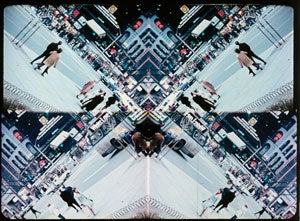What used to be called the Nederlands Filmmuseum has now renamed itself the EYE Film Institute, after moving in April to fabulous new digs across the IJ Canal in Amsterdam’s Overhoeks district, facing the old town and the train station. EYE’s new building features four cinemas: one with 300 seats, two with 120 seats, and one with 80 seats. There are also galleries for exhibitions, workrooms, a film lab, a shop and a café. According to EYE’s website, a future collections building near the new institute will house restoration, preservation and research activities, as well as the film library. This is good news, since the archivists at EYE have been at the forefront of preservation activities and technologies in Europe.

Paul Read and Mark-Paul Meyer’s "The Restoration of Motion Picture Film" (2000), for example, has become a standard work for all film preservationists. Recently, one of their younger colleagues, Giovanna Fossati, published "From Grain to Pixel. The Archival Life of Film in Transition" (2009, University of Amsterdam Press), which moves beyond analog film preservation to look at the way digital tools are being utilized for film preservation. The book is a revision of Fossati’s PhD thesis in the University of Utrecht, but also incorporates her experience teaching in the MA Film Archive program at the University of Amsterdam and her practical work.

In the first half of the book, "Practice and Theory of (Archival) Film," Fossati discusses traditional analog preservation technologies and the way they have been impacted by digital technologies. She makes the case that virtually all post-production work, especially editing, is now done in the digital realm, but that the goal is still 35mm output for movie theatres, even when the film was shot with digital cameras. Unfortunately in the three short years since the book was published, digitality has expanded so quickly to exhibition that the end of 35mm in commercial cinemas is now in sight, causing that part of her book to already be obsolete. More importantly, though, her discussion of digital restoration techniques and the possibilities for analog film material establishes standards and protocols for the work that all moving image archives will be increasingly involved with. Indeed, I find her flow charts for a mixed analog and digital work flow to be extremely helpful for the work we at UCLA are now undertaking with our new Diamant restoration suite. She also emphasizes some important precepts that have always guided our preservation work, but need to be remembered with new digital tools; for example, reversibility still needs to be a key tenant of our work.
In the second part of her book, "Theorizing (Archival Practice)," Giovanna Fosetti discusses the film philosophies of various major film archives, including the Danish Film Museum, EYE Film Institute and Anthology Film Archives, noting that their preservation decisions are based on whether they perceive film to be an art object necessitating screenings in the original format, or a “dispositive,” allowing the “content” to be disseminated in numerous analog and digital formats. She also discusses film laboratories, like Cineric (New York), as another social group other than archivists and film academics involved in the community project of film preservation and dissemination.

However, her final chapter, in which Fossati analyses the actual practical process of restoration and preservation of a number of films is of the most immediate benefit to moving image archivists and those interested in preservation. Among the projects she discusses are The Matinee Idol (1928, Frank Capra), preserved at Sony by Grover Crisp and Michael Friend, Mahagonny (1980, Harry Smith), restored by Anthology and the Harry Smith Archives, and Beyond the Rocks (1922, Sam Wood), restored by Fossati herself at the EYE Film Institute. Again, her flow charts and narrative demonstrate that digital tools are helpful in restoration, but never a panacea. So this is an important book, both as a document of a fast-moving transition period and as an indicator of where the future is taking us.






 Mobile Navigation
Mobile Navigation

